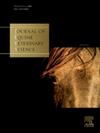Evidence of glycan mosaicism in the equine oviduct
IF 1.3
3区 农林科学
Q2 VETERINARY SCIENCES
引用次数: 0
Abstract
We report a lectin histochemical study of oviductal ampulla and isthmus of thirteen mares euthanised at anestrus (1), estrus (5), 1-day post-ovulation (5) or diestrus (2). Staining with a panel of 5 lectins recognizing N-Acetylgalactosamine (GalNAc) residues revealed mosaicism in glycan expression in some specimens of ampulla and isthmus, peaking at estrus and 1-day post-ovulation (ov+1). In the ampulla, this presented as positively stained areas of both ciliated and non-ciliated cells in otherwise negatively-stained ampullae, ranging from small foci (diestrus) to areas up to 200 microns in length or more (estrus and ov+1). No positive clusters were observed in anestrus. In the isthmus, there was 1 specimen at estrus exhibiting discrete areas lacking stain with all five GalNAc-binding lectins which showed strong staining in the rest of the tissue, while at ov+1, another specimen showed unstained areas with 3 of the 5 GalNAc binding lectins. In both isthmus cases, terminal lactosamine (Gal-GlcNAc-) and α2-3-linked sialic acid were present in the unstained foci but were negligible elsewhere. Other glycans did not appear to be affected in this way. Various lectins and pre-treatment to cleave terminal sialic acid residues were used to assess how terminal glycosylation might differ between areas showing mosaicism and other epithelial cells in the respective tissue compartments. We suggest that one explanation for this mosaicism may be that it has resulted from absence or activation of a GalNAc transferase in clones of cells, most likely the blood group A-related enzyme UDP-GalNAc:Fuc α1-2 Gal α1-3GalNAc transferase. These glycosylation patterns may affect the adherence of sperm and/or zygotes to these sites, and more studies are required to evaluate the extent of its occurrence and functional significance.
马输卵管中多糖嵌合的证据
我们报道了13只在发情(1)、发情(5)、排卵后1天(5)或发情(2)安乐死的母马的输卵管壶腹和峡部的凝集素组织化学研究。用识别n -乙酰半乳糖胺(GalNAc)残基的5种凝集素进行染色,发现在壶腹和峡部的一些标本中,多糖的表达具有嵌合性,在发情和排卵后1天(ov+1)达到峰值。在壶腹,这表现为阴性染色的壶腹纤毛细胞和非纤毛细胞的阳性染色区域,范围从小灶(发情期)到长达200微米或更长的区域(发情期和ov+1)。未发期未见阳性聚集。在峡部,有1例发情时的标本显示,5种GalNAc结合凝集素在分离的区域没有染色,其余部分组织呈强染色,而在ov+1时,另1例标本显示5种GalNAc结合凝集素中的3种未染色。在两例峡部病例中,未染色灶中均存在末端乳胺(Gal-GlcNAc-)和α2-3-链唾液酸,但在其他部位可忽略不计。其他聚糖似乎没有受到这种影响。使用各种凝集素和预处理来切割末端唾液酸残基,以评估在各自组织室中显示嵌合的区域和其他上皮细胞之间的末端糖基化可能有何不同。我们认为这种嵌合现象的一种解释可能是由于细胞克隆中GalNAc转移酶的缺失或激活,最有可能的是血型a相关酶UDP-GalNAc:Fuc α1-2 Gal α1-3GalNAc转移酶。这些糖基化模式可能会影响精子和/或受精卵对这些位点的粘附,需要更多的研究来评估其发生的程度和功能意义。
本文章由计算机程序翻译,如有差异,请以英文原文为准。
求助全文
约1分钟内获得全文
求助全文
来源期刊

Journal of Equine Veterinary Science
农林科学-兽医学
CiteScore
2.70
自引率
7.70%
发文量
249
审稿时长
77 days
期刊介绍:
Journal of Equine Veterinary Science (JEVS) is an international publication designed for the practicing equine veterinarian, equine researcher, and other equine health care specialist. Published monthly, each issue of JEVS includes original research, reviews, case reports, short communications, and clinical techniques from leaders in the equine veterinary field, covering such topics as laminitis, reproduction, infectious disease, parasitology, behavior, podology, internal medicine, surgery and nutrition.
 求助内容:
求助内容: 应助结果提醒方式:
应助结果提醒方式:


